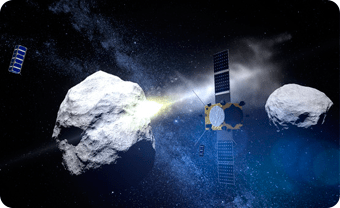Asteroids: a vision of the future

On 1 March GMV’s Madrid head office hosted the conference “Asteroids: A vision of the future”, bringing together members of the European Space Agency (ESA) and industry experts in asteroid exploration and future asteroid missions.
The event kicked off with a demo of the landing phase of the Asteroid Impact Mission (AIM) on platform-art©, GMV’s advanced robotics testbed. Then came the turn of expert presentations. First up came Nicolas Altobelli, ESA scientist from the Solar System Science Operation Division, presenting a paper called “Rosetta: a restrocpective on riding a comet…and more to come”. Next up came Andrea Accomazzo, Director of Operations of Rosetta and currently Head of the Solar and Planetary Missions Division of the European Space Operations Centre (ESOC), who gave the presentation “Rosetta: a precursor for Planetary Protection”. To round things off a projection of the mission was given by one of the world’s foremost specialists in the Sand Art technique.
The conference was held as a complement to ESA’s “Asteroid Impact Mission (AIM) Science Meeting” held on 1 and 2 March in the European Space Agency’s European Space Astronomy Centre (ESAC/ESA).
GMV is currently responsible for mission analysis and guidance, navigation and control (GNC) of the AIM mission. It is also contributing towards definition of operations to their target, the binary asteroid Dydimos.
AIM is an active part of the Asteroid Impact and Deflection Assessment (AIDA) project of ESA, DLR (Germany), the Observatoire de la Côte d´Azur (France), NASA, and Johns Hopkins University Applied Physics Laboratory (JHU/APL), designed to assess the potential of the kinetic impactor concept for deflecting nearby asteroids. The second component of this mission is the DART satellite (Double Asteroid Redirection Test), which is American. AIM’s 200-million-euro budget places it among low-cost missions. The fate of the AIM mission is to be decided in the upcoming Ministerial Conference scheduled for late 2016. If approved, AIM would be launched in 2020 aboard a Soyuz-ST rocket from French Guiana towards the Didymos asteroid. Arriving 18 months later, it would then begin its analysis of Didymoon while the binary asteroid system is passing about 11 million kilometers from Earth (30 times the Earth-Moon distance).
In October 2022 AIM will observe the 6 Km/s impact of the DART satellite against Didymoon. DART will be carrying a camera to record 20-centimeter-resolution images of the asteroid moments before the impact. AIM and DART will work jointly to determine the energy transfer resulting from DART’s impact against the secondary asteroid and monitor the dust environment before and after the impact as a function of time.